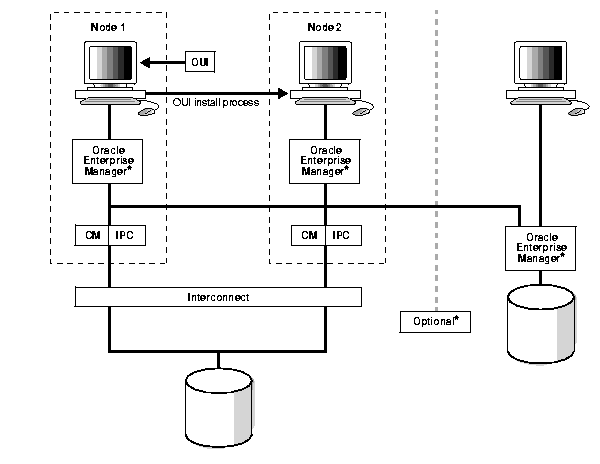Release 1 (9.0.1)
Part Number A89868-02
Home |
Book List |
Contents |
Index | Master Index | Feedback |
| Oracle9i Real Application Clusters Installation and Configuration Release 1 (9.0.1) Part Number A89868-02 |
|
This chapter provides an overview of the procedures and components involved in installing and configuring the Real Application Clusters software. This chapter includes the following topics:
Real Application Clusters software uses all the components of single instance Oracle environments plus cluster software that facilitates inter-node communication. This section, with Figure 1-1, briefly describes the process for installing this software.
The Oracle9i Enterprise Edition, which is required for Real Application Clusters, provides single instance database software and the optional software to operate Real Application Clusters databases. Some of the Real Application Clusters-specific components include:
The operating system clusterware contains operating system-dependent clusterware (OSD) components. The OSD clusterware controls the operating system and clusterware services required for Real Application Clusters. Its two primary subcomponents are the Cluster Manager (CM) and the Inter-process Communication (IPC) software.
The Cluster Manager monitors the state of all nodes and broadcasts information about the nodes throughout the cluster. This includes information about which nodes are active or inactive members of the cluster. The IPC layer controls messaging functions so the nodes can communicate with each other through the interconnect.
The OSD clusterware installation process varies according to platform. For UNIX operating systems, your vendor provides the OSD clusterware. For Windows NT and Windows 2000 operating systems, use the Oracle Cluster Setup Wizard to install the Oracle OSD clusterware after configuring your logical partitions as described in the online document, Oracle9i Database installation guide for Windows.
The Oracle Universal Installer (OUI) provides a graphical user interface for the installation of the Oracle Enterprise Edition software. Figure 1-1 shows the OUI process flow.

When the installer runs, Oracle Corporation recommends that you select one of the preconfigured databases or use the Oracle Database Configuration Assistant (DBCA) interactively to create your cluster database. You can also manually create your database with scripts provided you have properly configured your shared disks.
When you install Real Application Clusters, the installer copies the Oracle software onto the node from which you are running the installer. The Oracle Universal Installer then propagates the software onto the other nodes that you have identified as part of your cluster database.
The Oracle Universal Installer can also install the software for the system management tool, Oracle Enterprise Manager, to integrate this tool into your new cluster environment. Or you can install Oracle Enterprise Manager onto other nodes outside your cluster as shown in Figure 1-1 (*). You can also use Server Management (SRVM) and Performance Manager, which are subcomponents of Oracle Enterprise Manager, to administer Real Application Clusters environments as described in the next section.
You can use the Oracle Enterprise Manager Server Management (SRVM) subcomponent to start and stop Real Application Clusters databases. Use the Performance Manager subcomponent to monitor the performance of your Real Application Clusters database.
To operate, Oracle Enterprise Manager interacts with an Oracle Intelligent Agent which uses SRVM's SRVCTL Utility to control your Real Application Clusters database. Performance Manager interacts with the Intelligent Agent to monitor performance.
The Oracle Intelligent is installed when you install Oracle Enterprise Manager. The Oracle Intelligent Agent must reside on each node that is part of your Real Application Clusters database.
|
See Also:
Oracle9i Real Application Clusters Administration for information about using Server Management to administer Real Application Clusters environments and Oracle9i Real Application Clusters Deployment and Performance for information about using Performance Manager to monitor performance in Real Application Clusters environments |
All instances in Real Application Clusters environments share the control file, server parameter file, and each datafile. These files reside on shared disks that are accessed by multiple nodes. Each instance has its own discrete set of redo log files that also reside on the shared disks. During failures, this arrangement of shared access to redo log files allows surviving instances to perform recovery for failed instances.
The Real Application Clusters installation process includes four major tasks.
Verify that your system meets the requirements discussed under the following topics before proceeding with installation:
Verify the following hardware and software requirements for each node:
Each node in a cluster requires the following hardware:
Each node in a cluster requires the following software:
If you use Oracle Managed Files, your platform must support a cluster file system and the cluster file system must be supported by Oracle. The Oracle Managed Files feature automatically creates and deletes files that Oracle requires to manage the database. Cluster file systems are available only for a limited number of system types.
Interconnects that support Real Application Clusters and Cache Fusion use one of the following protocols:
Real Application Clusters can use any interconnect product that supports these protocols. You can also use other proprietary protocols that are hardware vendor-specific. The interconnect product you use must be certified by Oracle for your Oracle9i Real Application Clusters hardware platform.
32-bit instances cannot share the same 9.0.1 database with 64-bit instances. Depending on the platform, for example, 32-bit and 64-bit Oracle9i Real Application Clusters executables cannot be used at the same time within the same cluster domain. This is because some cluster manager implementations may not be able to concurrently handle 32-bit and 64-bit clients.
If you have installed and configured the required hardware and software, proceed to Chapter 2 to configure the shared disks by either:
|
|
 Copyright © 1996-2001, Oracle Corporation. All Rights Reserved. |
|